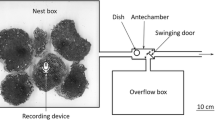Summary
Colonies and nests ofApoica pallens in the llanos region of Venezuela range from small foundress nests to large mature colonies. Nests are sited on small diameter, near-horizontal branches in a variety of shrub and tree species. During the day, adult wasps cluster on the face of the nest in an array that seems to be determined by orientation to gravity; defense of the colony against parasitoids and ants by the resting wasps may be more a passive than an active behavior. Wasps fan their wings to cool the colony during the day, but no foraging for water accompanies the fanning behavior. Nightly foraging activity begins with the explosive departure from the nest of hundreds of wasps, most of which rapidly return. Moderate foraging levels early at night give way to very low foraging levels in pre-dawn hours. The period of moderate foraging may be extended for longer hours during increased moonlight. Foraging wasps collect arthropod provisions for larvae. Larvae produce a trophallactic saliva; adults engage in inter-adult trophallaxis; brood are cannibalized. During cluster formation prior to swarm emigration, adult wasps do not appear to scent-mark substrates such as leaves. Instead,A. pallens exhibits a calling behavior, unique among polistine wasps studied to date, in which the gaster is held rigidly away from the thorax and metasomal sternal glands are exposed. Swarms can emigrate during the day.A. pallens may incorporate absconding and colony relocation as features of its colony cycle in the highly seasonal llanos.
Similar content being viewed by others
References
Carpenter, J. M., 1991. Phylogenetic relationships and the origin of social behavior in the Vespidae. In:The Social Biology of Wasps (K. G. Ross and R. W. Matthews, Eds.), Cornell Univ. Press, Ithaca, pp. 7–32.
Carpenter, J. M. and J. W. Wenzel, 1989. Synonymy of the generaProtopolybia andPseudo-chartergus (Hymenoptera: Vespidae: Polistinae).Psyche 96:177–186.
Downing, H. A., 1991. The function and evolution of exocrine glands. In:The Social Biology of Wasps (K. G. Ross and R. W. Matthews, Eds.), Cornell Univ. Press, Ithaca, pp. 540–569.
Ducke, A., 1905. Sobre as vespidas sociaes do Pará (I ° Supplemento).Boletim do Museu Goeldi 4:652–698.
Hunt, J. H., 1988. Lobe erection behavior and its possible social role in larvae ofMischocyttarus paper wasps.J. Insect Behav. 1:379–386.
Hunt, J. H., I. Baker and H. G. Baker, 1982. Similarity of amino acids in nectar and larval saliva: the nutritional basis for trophallaxis in social wasps.Evolution 36:1318–1322.
Hunt, J. H., P. A. Brown, K. M. Sago and J. A. Kerker, 1991. Vespid wasps eat pollen (Hymenoptera: Vespidae).J. Kans. Entomol. Soc. 64:127–130.
Hunt, J. H., R. L. Jeanne, I. Baker and D. E. Grogan, 1987. Nutrient dynamics of the swarm-founding social wasp speciesPolybia occidentalis (Hymenoptera: Vespidae).Ethology 75:291–305.
Jeanne, R. L., 1975. The adaptiveness of social wasp nest architecture.Quart. Rev. Biol. 50:267–287.
Jeanne, R. L., 1981. Chemical communication during swarm emigration in the social waspPolybia sericea (Olivier).Anim. Behav. 29:102–113.
Jeanne, R. L., 1991. The swarm-founding Polistinae. In:The Social Biology of Wasps (K. G. Ross and R. W. Matthews, Eds.). Cornell Univ. Press, Ithaca, pp.191–231.
Jeanne, R. L., H. A. Downing and D. C. Post, 1983. Morphology and function of sternal glands in polistine wasps (Hymenoptera: Vespidae).Zoomorphology 103:149–164.
Jeanne, R. L. and J. H. Hunt, 1992. Observations on the social waspRopalidia montana from peninsular India.J. Biosci. 17:1–14.
Naumann, M. G., 1970. The nesting behavior ofProtopolybia pumila in Panama (Hymenoptera: Vespidae). Ph. D. dissertation, University of Kansas, Lawrence.
Rau, P., 1933.The Jungle Bees and Wasps of Barro Colorado Island. privately published, Kirkwood, MO.
Richards, O. W., 1978.The Social Wasps of the Americas Excluding the Vespinae. British Museum (Natural History), London.
Richards, O. W. and M. J. Richards, 1951. Observations on the social wasps of South America (Hymenoptera Vespidae).Trans. R. Ent. Soc. Lond. 102:1–169 + 4 plates.
Sarmiento, G., 1983. The savannas of tropical America. In:Ecosystems of the World 13: Tropical Savannas (F. Bourlière, Ed.). Elsevier, Amsterdam, pp. 245–288.
Saussure, H. de, 1853–1858.Études sure la famille des vespides.2. Monographie des guêpes sociales, ou de la tribue des vespiens. Masson, Paris.
Schremmer, V. F., 1972. Beobachtungen zur Biologie vonApoica pallida (Olivier, 1791), einer neotropischen sozialen Faltenwespe (Hymenoptera, Vespidae).Ins. Soc. 19:343–357.
Vecht, J. van der, 1972. The social wasps (Vespidae) collected in French Guyana by the mission du Muséum National d'Histoire Naturelle with notes on the genusApoica Lepeletier.Ann. Soc. ent. Fr. (N.S.) 8:735–743.
Vesey-FitzGerald, D., 1938. Social wasps (Hym. Vespidae) from Trinidad, with a note on the genusTrypoxylon Latreille.Trans. R. Ent. Soc. Lond. 87:181–191.
Wenzel, J. W., 1991. Evolution of nest architecture. In:The Social Biology of Wasps (K. G. Ross and R. W. Matthews, Eds.). Cornell University Press, Ithaca, pp. 480–519.
Author information
Authors and Affiliations
Rights and permissions
About this article
Cite this article
Hunt, J.H., Jeanne, R.L. & Keeping, M.G. Observations onApoica pallens, a nocturnal neotropical social wasp (Hymenoptera: Vespidae, Polistinae, Epiponini). Ins. Soc 42, 223–236 (1995). https://doi.org/10.1007/BF01240417
Received:
Revised:
Accepted:
Issue Date:
DOI: https://doi.org/10.1007/BF01240417




